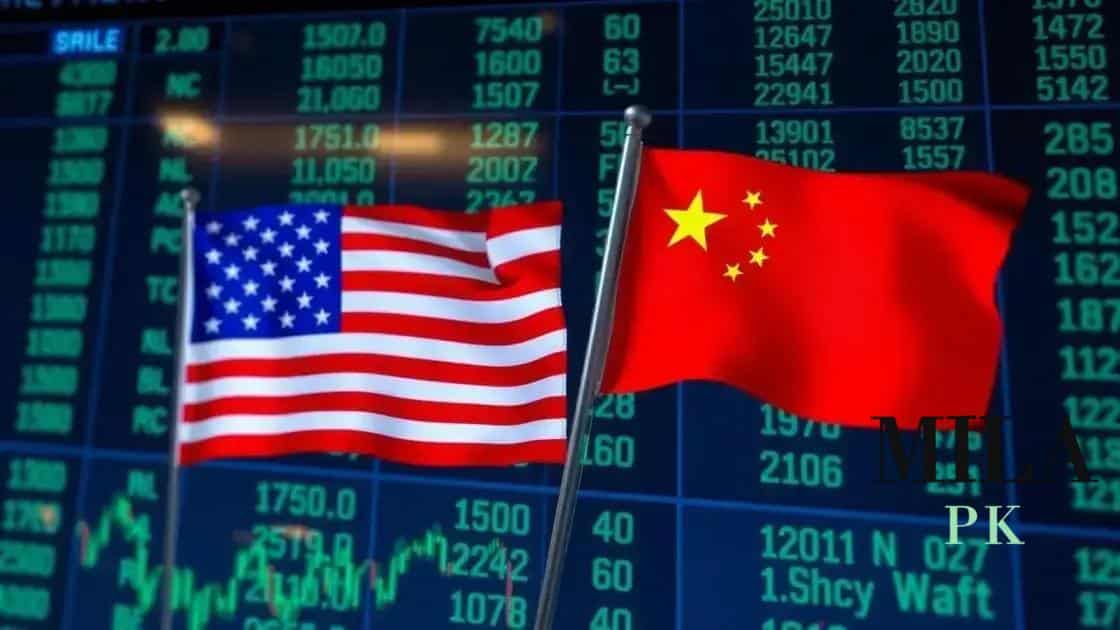Financial repercussions of the US-China trade conflict

The financial repercussions of the US-China trade conflict include increased tariffs leading to higher consumer prices, disruptions in global supply chains, and a heightened competition in technology between the two nations.
The financial repercussions of the US-China trade conflict are far-reaching and complex. As tensions rise, they shape not just bilateral relations but also the global economy. Have you noticed changes in prices or availability of products? Let’s delve into these dynamics.
Understanding the trade conflict’s origins
The trade conflict between the US and China did not just emerge overnight; it has deep historical roots. To fully grasp its complexities, we must understand the factors that led to these escalating tensions. This involves looking at trade practices, economic policies, and cultural differences that span decades.
Historical Context
Since China joined the World Trade Organization in 2001, its economy has grown rapidly. This shift altered global trade dynamics, creating both opportunities and challenges for the US. Some American industries began to feel the pressure of Chinese competition, which led to concerns about job losses and industry declines.
Key Issues
Several key issues have fueled the conflict, including:
- Trade Imbalance: The US has faced a significant trade deficit with China.
- Intellectual Property Theft: Concerns have risen over China’s practices regarding intellectual property rights.
- Currency Manipulation: Allegations that China has controlled its currency to gain trade advantages.
- Technological Competition: Emerging technologies have heightened competition in sectors like AI and telecommunications.
These elements created a sense of urgency around negotiations. The US government imposed tariffs on Chinese goods, aiming to level the playing field. This action led to immediate repercussions, sparking retaliatory measures from China, which only deepened the conflict.
Looking at the global perspective, this conflict impacts not just the two nations, but also other countries involved in the supply chain. Companies worldwide have had to reevaluate their strategies to mitigate risks associated with these tensions. For example, some businesses are moving production away from China to avoid tariffs, which alters global manufacturing processes.
In summary, understanding the origins of this trade conflict is essential for grasping its current implications. By examining historical and economic factors, we can better appreciate the challenges that lie ahead for both the US and China as they navigate their complicated relationship.
Key impacts on global supply chains
The US-China trade conflict has significantly reshaped global supply chains. These changes are not just felt in the two countries involved, but resonate throughout various industries worldwide. As businesses adapt to new tariffs and trade restrictions, it’s important to understand the key impacts this conflict has on their operations.
Disruptions to Supply Chains
One of the most immediate consequences of the trade conflict is the disruption experienced by many supply chains. Companies that rely on parts and materials from China have faced delays and increased costs. These disruptions force companies to rethink their supply chain strategies.
Shifts in Manufacturing Locations
Many businesses are relocating their manufacturing processes to avoid tariffs. Southeast Asian countries, such as Vietnam and Thailand, are increasingly becoming popular alternatives for companies looking to maintain production without incurring additional costs. This shift impacts local economies and creates new supply chain dynamics.
Increased Costs for Consumers
As companies adapt to the changing landscape, consumers may notice higher prices for various goods. This price increase occurs as businesses pass on the additional costs of tariffs and new manufacturing locations. Understanding these trends helps consumers make informed decisions in buying products.
On the other hand, some companies are innovating in response to these supply chain challenges. They are investing in technology and automation to enhance efficiency and reduce reliance on any single country for production. This push for innovation contributes to overall resilience in global supply chains.
Overall, the impacts on global supply chains are multi-dimensional and constantly evolving. As businesses navigate these changes, they must stay informed and agile to ensure their success in a global market that is increasingly interconnected.
How tariffs affect consumer prices
Tariffs have a direct impact on consumer prices, influencing what we pay for many products. When the US government imposes tariffs on imports from China, the costs often rise for businesses that import those goods. These companies typically pass on the additional costs to consumers, leading to higher prices in stores.
Understanding Tariffs
Tariffs are taxes imposed on imported goods. They are designed to protect domestic industries by making foreign products more expensive. When tariffs are enacted, businesses importing these goods face increased costs. As a result, they may raise their prices to maintain profit margins.
Effects on Different Products
The types of products affected by tariffs vary widely. Common examples include:
- Electronics: Devices like smartphones and laptops may become pricier due to tariffs.
- Clothing: Tariffs on fabric and apparel can lead to higher prices at retail stores.
- Household Goods: Items such as furniture and appliances often see price increases as well.
- Food Products: Some agricultural goods may become more expensive due to tariffs on imports.
These price increases are significant for consumers. As tariffs raise expenses, household budgets can be tightened, making it important to understand which products may cost more in the future. Furthermore, the ripple effect of tariffs can lead consumers to seek alternatives or change their purchasing habits.
In some cases, consumers might notice that domestic products become more appealing due to lower prices compared to their imported counterparts. This shift can encourage support for local manufacturing but may also result in limited choices for consumers.
Overall, tariffs can lead to a chain reaction affecting consumer prices across various markets. Being aware of these changes can help consumers make informed decisions about their purchases.
The role of technology in trade relations

Technology plays a crucial role in shaping trade relations between countries, particularly in the context of the US-China trade conflict. Advances in technology impact everything from communication to logistics, making trade more efficient yet also more complex.
Enhancing Communication
Technology facilitates instant communication between businesses and government agencies across borders. This allows for quicker decision-making, which is essential in a fast-paced trading environment. For instance, digital platforms enable companies to connect with suppliers and customers worldwide with ease.
Impact on Supply Chains
With the rise of technology, supply chains have become increasingly integrated. Companies can track shipments in real time, which reduces delays and improves inventory management. Some key technologies affecting supply chains include:
- Artificial Intelligence (AI): AI helps businesses forecast demand and optimize logistics.
- Blockchain: This technology enhances transparency and security in transactions.
- Internet of Things (IoT): IoT devices provide real-time data on goods in transit.
- Automation: Automated systems in warehouses streamline operations, reducing costs and errors.
Despite the benefits, technology also introduces challenges. For example, as companies increase their reliance on technology, they must also consider risks such as data breaches and cyberattacks. These threats can disrupt operations and impact trade relations negatively.
Moreover, the competition in technological advancements between the US and China is transforming trade relations. Both nations are investing heavily in areas like artificial intelligence and 5G technology, aiming to establish dominance in emerging markets. This race for technological supremacy can influence policies that further complicate trade dynamics.
In summary, technology serves as a double-edged sword in trade relations. While it promotes efficiency and innovation, it also creates new challenges that businesses and governments must navigate carefully.
Future predictions for US-China economic ties
The future of US-China economic ties is uncertain and filled with potential changes. Both countries are crucial players in the global economy, and developments in their relationship can reshape markets worldwide. Understanding where these ties might lead is essential for businesses and policymakers alike.
Trade Agreements and Policies
Future predictions suggest that both countries may seek new trade agreements to ease tensions. However, these agreements will likely come with conditions that address issues like intellectual property and trade imbalances. Negotiations may focus on mutual benefits to foster a more balanced economic relationship.
Technological Competition
The race for technological supremacy will play a significant role in shaping future economic ties. Both nations are investing heavily in emerging technologies. Future collaborations or competitions in fields like artificial intelligence and renewable energy could become focal points. Companies in both countries may need to innovate continuously to remain competitive.
Impact on Global Markets
The economic ties between the US and China also affect global markets significantly. Changes in tariffs or trade policies can result in fluctuations in commodity prices around the world. For instance, if a trade deal reduces tariffs, it could stimulate global trade and lower prices. Conversely, escalating tensions could lead to increased costs for consumers.
Furthermore, global supply chains may adapt to align with the evolving dynamics between the two nations. As businesses become aware of potential risks, they may diversify their supply sources to avoid reliance on one country.
Lastly, the involvement of other countries will also shape future predictions for US-China economic ties. Nations in Asia, Europe, and beyond will be watching closely, as their economies are intricately linked to the relationship between these two superpowers.
The future of US-China economic ties remains dynamic and uncertain. Both nations will likely seek new trade agreements that can address underlying issues and improve their relationship. The technological race between the US and China will continue to shape these ties, impacting industries around the globe. As we anticipate the effects of tariffs and trade policies, consumers and businesses must stay informed about potential price changes and market fluctuations. Global supply chains will evolve in response to these developments, highlighting the interconnected nature of the world economy. Collaboration and competition will coexist, creating both challenges and opportunities for countries involved in this intricate relationship.
FAQ – Frequently Asked Questions about US-China Economic Ties
What are the main factors influencing US-China trade relations?
Key factors include tariffs, technology competition, and trade agreements, all of which shape the economic landscape between the two countries.
How do tariffs impact consumer prices?
Tariffs increase the cost of imported goods, which businesses often pass on to consumers, leading to higher prices.
What role does technology play in US-China economic ties?
Technology affects communication, supply chain efficiency, and competition in emerging sectors like AI and renewable energy.
What should businesses do to prepare for changes in trade relations?
Businesses should diversify their supply chains and stay informed about policy changes to mitigate risks and capitalize on new opportunities.





